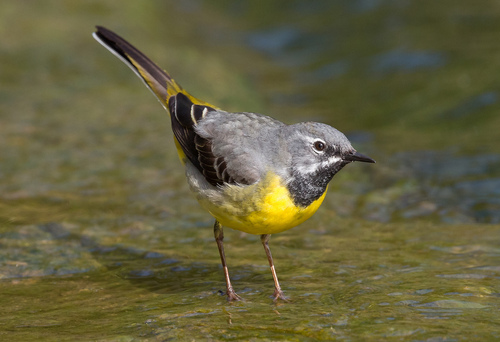
Grey Wagtail
The Grey Wagtail (Motacilla cinerea) is a slender, elegant bird known for its long tail, which it constantly wags up and down, a characteristic behavior of the *Motacilla* genus. Despite its name, the 'grey' refers to the bird's back; it is more readily identified by its bright yellow underparts, particularly vibrant in breeding males. This species plays an important ecological role as an insectivore, controlling populations of various invertebrates in riparian and wetland habitats. It is not typically associated with strong cultural significance but is often appreciated by birdwatchers for its beauty and lively behavior.
18-19 cm
Length
25-27 cm
Wingspan
Least Concern
Conservation Status
Distribution
The Grey Wagtail has a wide distribution across Eurasia, breeding from the British Isles and Scandinavia eastwards to Japan and Kamchatka. It also breeds in parts of North Africa. Northern populations are migratory, wintering in southern Europe, Africa south of the Sahara, and southern Asia. Altitudinal range varies, found from sea level to high mountain streams.
Lifespan
Typical lifespan in the wild is not well-documented, but likely around 2-3 years. Some individuals may live longer, up to 5 years or more in captivity, though this is not representative of wild conditions.
Grey Wagtail's Habitat
Habitat Types
Fast-flowing rivers and streams, Rocky upland areas, Wetlands, Lakesides, Canals, Sewage farms (during migration or winter)
Climate Zones
Temperate, Boreal, Subtropical (in parts of its range)
Adaptations
Grey Wagtails are adapted to foraging in fast-flowing water. Their long legs and toes help them navigate slippery rocks and shallow streams. Their constant tail-wagging is thought to help flush out insect prey or maintain balance on uneven surfaces.
Variations
Several subspecies are recognized, differing slightly in plumage coloration and size. For example, *M. c. cinerea* is found in western Europe, while *M. c. melanope* occurs in eastern Asia.
Appearance
Breeding Plumage
Breeding males have a black throat and brighter yellow underparts. Females and non-breeding males have a paler, whitish throat and less intense yellow underparts.
Seasonal Feather Changes
The intensity of yellow on the underparts can fade somewhat in winter, becoming paler.
Sex Based Plumage Differences
Males have a black throat during the breeding season, which is absent or much paler in females.
Notable Features
Long, constantly wagging tail, Bright yellow underparts (especially in breeding males), Grey upperparts, White supercilium (eyebrow stripe), Black wings with white wingbars
Diet and Feeding
Primary Foods
Aquatic invertebrates, Flies, Beetles, Small crustaceans, Spiders, Occasionally small fish or tadpoles
Foraging Behavior
Grey Wagtails typically forage by walking or running along the edges of streams and rivers, picking insects from the water surface, vegetation, or rocks. They also make short flights to catch flying insects.
Specializations
Their agility and quick reflexes are key adaptations for catching fast-moving insects. The long tail aids in balance while navigating uneven terrain and pursuing prey.
Seasonal Diet Variations
Diet may shift slightly depending on insect availability. During the breeding season, they may focus more on aquatic insects, while in winter, they might consume more terrestrial invertebrates.
Behavior
Social Structure
Generally solitary or found in pairs during the breeding season. Outside of breeding, they may form small, loose flocks, especially during migration or at winter roosts.
Communication
A distinctive, sharp 'zit-zit' call, A more complex song consisting of trills and whistles, often given during flight displays, Tail-wagging, likely a form of visual communication
Migration
Northern populations are migratory, undertaking long-distance journeys to warmer regions. Migration occurs in small flocks, often following river valleys. Timing varies, but generally occurs in autumn (southward) and spring (northward).
Territorial or Group Behaviors
Highly territorial during the breeding season, defending a stretch of river or stream. Males will chase away intruders with vigorous displays and calls.
Conservation
Threats
Habitat degradation (e.g., river pollution, channelization), Climate change (affecting insect emergence and breeding success), Loss of riparian vegetation, Pesticide use (reducing insect prey)
Protection Programs
General habitat protection measures, Legislation protecting water quality, Some site-specific conservation efforts for important breeding or wintering areas
Local National Laws
Protected under various national and international wildlife laws, such as the Birds Directive in the European Union.
Population Trend
Stable
Population Estimates
The global population is estimated to be large, with several million individuals. However, some regional populations may be declining due to local threats.
Interesting Facts
They are known for their characteristic tail-wagging.
The constant up-and-down motion of the tail is thought to help flush out insect prey or maintain balance.
They can often be found near human habitation.
They will utilize canals, sewage farms, and even urban streams if suitable habitat is available.
They are highly agile fliers.
They are capable of catching insects in mid-air with impressive speed and maneuverability.
The oldest recorded Grey Wagtail lived to be over 10 years.
BTO reported a ringed bird reached 10 years and 10 months.
Faqs about Grey Wagtail
Why do Grey Wagtails wag their tails?
The exact reason is not fully understood, but it's likely a combination of factors, including flushing out prey, maintaining balance, and communication.
Are Grey Wagtails related to Pied Wagtails?
Yes, they are both members of the *Motacilla* genus (wagtails) and the Motacillidae family.
Where can I see a Grey Wagtail?
Look for them near fast-flowing streams, rivers, and rocky areas, particularly in upland regions. They can also be found in wetlands and near canals.
Do Grey Wagtails migrate?
Yes, northern populations are migratory, moving south for the winter. Birds in milder climates may be resident year-round.
Copyright @ Nature Style Limited. All Rights Reserved.
 English
English